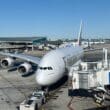While it doesn’t come as a surprise, Spirit Airlines started the holiday weekend by declaring Chapter 11 Bankruptcy for the second time in less than a year. The ultra-low-cost carrier (ULCC) restructured earlier this year but has continued to struggle financially.
Spirit Declares Chapter 11 Bankruptcy
While I was surprised by the timing of the news, late in the afternoon on a Friday before a holiday weekend, I wasn’t surprised to see Spirit declare bankruptcy for the second time in under a year.
Spirit’s financial situation has been on shaky ground since the pandemic and, in recent years, the carrier has been hemorrhaging cash as it attempts to make changes to its business model to help return to profitability.

The carrier has been plagued with a significant amount of debt as well as significant, ongoing, operating losses. Earlier this month the airline informed the Securities and Exchange Commission (SEC) that there was “substantial doubt” that the carrier could continue operations for another year.
In an attempt to turn a profit amid a shift in consumer preferences, Spirit has made multiple adjustments to its business. This included overhauling its fare bundles in an effort to move towards a more premium product. The airline has also furloughed and downgraded pilots for a second time as it looks for ways to turn a profit.
Now, with its most recent bankruptcy filing, Spirit stated it intends to use the Chapter 11 process to “implement the broad changes necessary to transition the Company for a sustainable future and position it to deliver the best value in the sky for years to come.”
What Happens Next?
While Spirit’s first bankruptcy seemed rushed and didn’t really address many of the major issues at the carrier, at least this filing makes it sound like they are finally ready to change.
In its bankruptcy filing, Spirit acknowledged that the Chapter 11 process will provide it with the tools, time and flexibility to continue ongoing discussions with all of its lessors, financial creditors and other parties to implement a financial and operational transformation.

As part of its most recent bankruptcy, the company plans to:
- Redesign its network: Focus its flying on key markets to provide more destinations, frequencies and enhanced connectivity in its focus cities. It will also reduce its presence in certain markets.
- Optimize its fleet size: Right size the fleet to match capacity with profitable demand in line with the redesigned network. Significantly lowering Spirit’s debt and lease obligations.
- Address its cost structure: Reinforce efforts to build on its industry-leading cost model by pursuing further efficiencies.
- Effectively compete and meet evolving consumer preferences with its three travel options – Spirit First, Premium Economy and Value: Take full advantage of its lower costs to offer consumers more of what they want. The airline will expand the opportunities for travelers to choose premium options while remaining true to its original mission of making travel more accessible for everyone.
Dave Davis, President and Chief Executive Officer at Spirit, said this about the filing:
“Since emerging from our previous restructuring, which was targeted exclusively on reducing Spirit’s funded debt and raising equity capital, it has become clear that there is much more work to be done and many more tools are available to best position Spirit for the future. After thoroughly evaluating our options and considering recent events and the market pressures facing our industry, our Board of Directors decided that a court-supervised process is the best path forward to make the changes needed to ensure our long-term success. We have evaluated every corner of our business and are proceeding with a comprehensive approach in which we will be far more strategic about our fleet, markets and opportunities in order to best serve our Guests, Team Members and other stakeholders.
As we move forward, Guests can continue to rely on Spirit to provide high-value travel options and connect them with the people and places that matter most,” Davis continued. “On behalf of our Board and leadership, I want to thank our Team Members for their continued dedication, resilience and commitment to delivering a safe, reliable operation and excellent service to our Guests.”
Though it seems like Spirit plans to continue operations as part of this restructuring and find a path back to profitability, I really only see two possibilities here. The first, and most likely in my opinion, is that Spirit finally merges with fellow ULCC Frontier.

The Indigo Partners corporate jet, the parent company of Frontier, was spotted in Fort Lauderdale earlier this week. This happened shortly after Frontier launched 20 routes directly aimed at Spirit. The two have flirted with a merger in the past and I believe this is the most likely scenario.
The second option is that the carrier is broken apart and sold for parts. While I personally believe this is unlikely, I’ve spoken with a few Spirit crewmembers that have heard rumors of Southwest being interested in the airline. With Southwest operating an all Boeing fleet and Spirit operating an all Airbus fleet, I have to assume Southwest would only be interested in slots and gates.
Ultimately this process will have to wind its way through the bankruptcy courts but, I’d be shocked if Spirit comes out of this bankruptcy intact.
Summary
Spirit Airlines declared Chapter 11 Bankruptcy today for the second time in less than a year. The ultra-low-cost carrier has been struggling financially for years and its clear that the first bankruptcy didn’t solve the financial struggles facing the airline. Now it seems poised to make the necessary changes but, ultimately, I don’t see a path forward for the airline.






